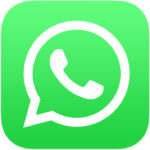
Naming & Branding Expert
Table of Contents
The Ultimate 8-Step Guide To Naming app
Are you in the process of making a revolutionary mobile app? Have you thought of potential names for it? Well, we are here to help you with that.
In today’s ultra-competitive mobile app marketplace, you only have one chance to make a perfect impression. That impression will largely be influenced by the app’s face: the name and the logo. That’s why it is essential to find the most appropriate and appealing name for your app right from the onset.
My name is Libby, and I am a brand expert. In this step by step guide I will guide you through the naming process.
Not only that, I will also share 7 things you should avoid while choosing name for your mobile application.
Step 1: Outline What the Name Should Represent
When trying to come up with good app names, it’s important that you first think of them in relation to your brand.
What is in a app names? A lot is in a name, but what really stands out in any name is what it represents. It is what your application ultimately stands for. You want the name to explain to the target audience who you are and how your services can be of use. That will make the business easier to find and more appealing to potential users.
At this stage of your naming process, here is a list of questions you can ask yourself and the people around you to figure out what exactly your app represents.
- Does the app represent a company, a product, or a service?
- How unique do you want the app to be with respect to existing apps?
- How culturally sensitive is your app idea? How sensitive is the brand/products/services it represents?
- What are your growth prospects? Do you need a name that will remain relevant for future products and brand extensions?
- What’s that one trait or feature that you want users to know your app for?
- What’s your confidence in the app’s ability to revolutionize the market?
Bottom line: There is no magic formula for explaining what your app name idea represents. What’s important is to identify your target market and then focus on making positive and meaningful emotional connections with them. Find names that cannot in any way jeopardize that objective.
Step 2: Competitive Analysis
Your task in this step is to analyze local or international companies from same field and figure out what inspired their name. Then you can come up with strategies to do it better.
The big question is, “how exactly did they get their naming on point?”
An easy way to do this is to find a number of app names on the internet, evaluate their logo and positioning. This will tell you a lot about how each one derived its name and established a brand.
An exhaustive competitive analysis will give you an objective understanding of the competition’s strengths and weaknesses. That information will help you position your cool app name in a unique way that outshines the competition.
How to Do a Competitive Name Analysis
How do you analyze competitors’ app names and logo designs? Follow our simple template:
- Pick a few competitors (preferably industry leaders).
- Check out their name. What does the name say, and how does it relate to what they do?
- Analyze the logo. What does it represent?
- How do their name and logo contribute to their success?
To give you an idea of what we mean, please check out our analysis of these three leading businesses:
[3-4 businesses Competitive Analysis
company – where it got its name from, what is in company`s name, whats in company logo]

WhatsApp:
In the words of Jan Koum, the WhatsApp co-founder and former CEO: “WhatsApp is a pun on What’s Up”.
What’s in the name? The name was motivated by Jan’s desire to enable friends to check on each other without necessarily asking “what’s up”. You can tell from the name that the app is a chat platform.
What does the WhatsApp logo represent? The logo is a white phone receiver icon that’s embedded in a green text bubble. It portrays the function of the app. The text bubble represents instant messaging while the receiver symbolizes the app’s call function. The blending of white and green colors represents the app’s freshness.

Instagram:
Systrom and Krieger, the founders of Instagram, got their name by merging “insta” from “instant camera” with “gram” from “telegram”.
What’s in the Instagram name? The name represents the “right here, right now” concept of Instagram’s photo-sharing function. The name also somehow rhymes with glam. Many users associate Instagram with glamour and elegance. That’s the catch.
What’s in the Instagram logo? Their logo is rainbow-themed which, according to the company, represents the diversity that makes the Instagram community. The colors also bring life, warmth, energy, and color to the platform. Furthermore, the logo resembles the camera icon in most smartphones, so users automatically associate it with photos.

TikTok:
This is arguably the fastest-growing app in the world right now. The name TikTok is derived from the name “tick-tock”, which is the sound clocks make when ticking.
What’s does the TikTok name represent? The name represents the minute-by-minute countdown of the short lip-synched music videos that users post on the app. That aside, the nice play of words evidently excites youthful users who are the app’s main target market.
What’s in the TikTok logo? The TikTok emblem is a representation of neon colors (pink, blue, black, and white) in 3D. It shows the rock-concert nature of the app and the endless music vibrations that users experience on the app.

Bottom line: You can tell from the three examples that it’s by no coincidence that some app names become so relatable and memorable. The feel in the logo and the messaging in the name help the business stand out from the crowd.
Step 3: Gather a List of Your Name Ideas (Brainstorm)
The next step for you is to brainstorm possible app name ideas. Write them down as they come; do the weeding later.
When you have 20-40 names that fit your niche and vision, and that can compete successfully with existing competitors.
Next, split your list of names into the 4 categories listed below. Let’s see a quick demonstration assuming you’re trying to come up with cool app names centered on business.
- Descriptive names: In this approach, the name should describe the service or product of your business at first glance.
Here are 5 descriptive names we brainstormed for the purpose of this article:- FilmStream for a video streaming app.
- AutoPark for an IoT-based parking app.
- PhotoMaker for a photography-related app.
- Ambo247 for an emergency health service app.
- Pooch for a dog-walking service app.
- Suggestive names: Suggestive names create a vivid image that resonates with the prospective user. Suggestive app names hint at an underlying meaning to the name, instead of just putting it out there. You can go with this category if you’re trying to get creative.
Good examples for suggestive names are:- VirtualChef for a kitchen or food-related app.
- lust for a tour and travel app
- iFeelU for a romantic app.
- myAlphabets for a language learning app.
- meSing for a karaoke app.
- Abstract names: Abstract names are memorable and catchy, but they don’t have any apparent connection with their services or products. The names are purely made up, so they easily establish dominance in the market. Google, Yahoo, Nike, and Skype are examples of abstract names.
Some abstract name ideas for iOS or android business app are;- Momo: Playful, short, and memorable.
- Grint: Odd and interesting
- Yoffa: Soft, playful, and catchy.
- Xynn: Strong and daring.
- Groop: Memorable, catchy, and authoritative.
- Legacy names: naming your mobile application with legacy in mind means that you want it to outlive you. If this is what you prefer, you can just name it after yourself or an organization you founded. The luxury sports car Ferrari, for example, is named after its founder, Enzo Ferrari.
We brainstormed these examples:- Your name, e.g.: Zelda
- Cool acronyms, e.g.: Bae for a romantic app.
- The name of a city/place that people can associate the app with, e.g.: Santorini for a vacation app.
- A popular movie or book such as Romeo or Titanic for a romantic movie.
- Your initials if they are cool, e.g.: R&L
Step 4: Generating Names
Are you still stuck on a application name to go with? Try our app name generator.
This app name generator provides you names using AI algorithm match. It’s unique, it’s fresh and it was made for you.
All you have to do is type your keyword (Main application goal or function) in the search bar. In a matter of seconds, you get powerful app name ideas for your mobile application. Our algorithm is designed to learn your preferred keywords over time and consequently recommend the most suitable options for you.
Once you find the names you like, instant domain zone availability checker will show you what zones are available for registration. This AI based app name generator will also get you some logo recommendations based on the name of your mobile app. This tool saves you a lot of time and the best part? It is totally free!
Ready to find your business name?
Step 5: Shortlisting your name ideas
It’s weeding time! This is where you prune and pick only the best and cool names for your app. Your shortlist should have about 3-5 names off your initial list.
Picking your favorite app name may be tough, especially if you used our app name generator. There are a few things you need to consider when creating a shortlist.
- Keep it simple. Good app names should be unique, but mostly simple. Simple names are easily remembered.
- Check for linguistics and context. Do a quick google search of your names to find out what they mean in other languages- especially your target countries. If any of them has an offensive meaning in another language, it’s best to go with a different name.
- Sometimes owners choose names that later become controversial especially in overseas markets. Don’t make that mistake. Eliminate any chances of the name being misinterpreted as sexist, homophobic, racist, or offensive in any way to any community.
- Tagline check. If you haven’t come up with a tagline at this point, take a pause and do that. It’s important that your chosen app name aligns with your tagline, which is also your slogan.
It is your prerogative to decide the elimination criteria, but this checklist should help you shorten your list:
- Is the name culturally sensitive?
- Does the name capture the values and vision of your brand?
- Does the name align with your tagline? If you don’t have a tagline ready, you need to create it at this point and align it with your preferred app name.
- How relatable is the name to the target audience?
- Of the most relatable names, which ones are the easiest to remember?
- Can your target audience pronounce the name easily and accurately?
- How original does the name sound? You don’t want clichés and plagiarized names.
Reduce your list from the original 20-40 names to about 3-5 names.
Step 6: Background Check
Once you have shortlisted the best app names, background checks are necessary. A background check might just save you from future legal battles and cases of misinterpretation. Here are a few things to do in a background check.
- Research Legality: You do not want to get in trouble with the law because you’re starting a mobile application business. So, find out if your intended app names and taglines are in accordance with the law of your home country. Do this for each name on the shortlist. If any of them does not pass the test, drop that name and move on with the others.
- Trademark Check: to avoid cases of trademark infringement down the line, find out if your app name or logo is already trademarked by another organization. If it’s not, you have the go-ahead to register it as your own trademark.
- Readability: is your app name easy to read and understand? You can get an external opinion on the readability of your app name and tagline. If it’s not, you have the opportunity to fix that because you’re not creating it for yourself alone.
Step 7: Get some Feedback
You have narrowed down your 20-40 name list to 2-3 names at this point.
Simple step: It’s great to have the opinion of a third-party when you’re done with the primary checks. Their opinion may differ from yours, but it’s mostly objective criticism so that’s okay. You can show a list of your final 2 club names to;
- People who run or developed successful mobile applications.
- Your target audience.
If you’re asking your ideal audience, ask the first thing they thought of on hearing that name. Once you get feedback, go back and figure out if their response was in favor of your app name or not. Ask yourself if the name evoked the thoughts, you had imagined it would.
Pro Step: If you want to go deeper with the feedback step you can reach out to opinion shapers, industry leaders, your ideal customers, linguists, and tech futurists for their opinions.
- Tech futurists will help you predict and reshape the future prospects of your new app name ideas within the global tech space.
- Linguists will advise on the name’s readability and lingual appropriateness.
- Opinion shapers and industry leaders will help you predict the app’s probable reception in the real world.
- Ideal customers will tell you whether the app names represents a need they would purchase.
Pro tip: Don’t rely too much on feedback from biased people, especially fans, friends, family members, and colleagues. Seek the opinion of brutally honest critics.
Step 8: Check if the name is available
You have come a long way in trying to name your mobile app. Now, the final step is to check if your app name and extension of choice are available for domain registration. You can use our name availability checker to run a quick check after you have generated name ideas for your app. Our free tool shows you which domain extensions are available, and will recommend logo ideas that correspond with your app name. Or you can Google the shortlisted names to ensure that they aren’t plagiarized. Looking up the names will also give you an idea of what each name might mean to different internet users.
The app name generator and availability checker are highly recommended, to make your mobile application name stand out from the rest.
Ready to find your business name?
7 Things to Avoid While Naming App
- Complex Names. In a bid to come off as creative or different, a lot of people come up with names they shouldn’t be using for a application name or any establishment at all. You can get creative, but don’t complicate things for yourself and your audience by using names that are difficult to read and spell.
- Copying a Competitor’s Style. The competitive analysis is for you to study the marketplace, and get inspired with ideas that are original to your brand. Copying the style, name or logo of another mobile app takes away the originality from your project.
- Skipping Background Checks. Do not for any reason, skip the background checks detailed in Step 6. That is, if you hate the discomfort of legal battles and run-ins with the law enforcement.
- Shortcuts. There are no shortcuts to success. Even when naming your mobile app, you have to follow through with the recommended steps. Cutting corners may cost you more in the long run.
- Don’t limit the name to a specific language or geographical location. That will in most cases minimize the future growth prospects.
- Don’t use words that are too plain or cliché to outstand from a crowd. In the same breath, don’t choose names that too obscure, technical, or difficult.
- Don’t be too stubborn or biased that you cannot accept negative feedback for the names you like.
To save time, you can use our random app name generator to quickly find good names. Name ideas from the name generator are catchy, simple and unique to you.
Try out our app name generator for free today!
